Technology has transformed the way people interact with the world, and for visually impaired individuals, it has opened doors to greater independence. From navigating streets with ease to reading books, sending messages, and accessing information, assistive technology has become a game-changer.
Today, there are countless innovations designed specifically to support people with visual impairments. Some devices help individuals move around safely, while others make it easier to use computers, smartphones, and household appliances. With the right tools, visually impaired individuals can lead more independent, fulfilling lives.
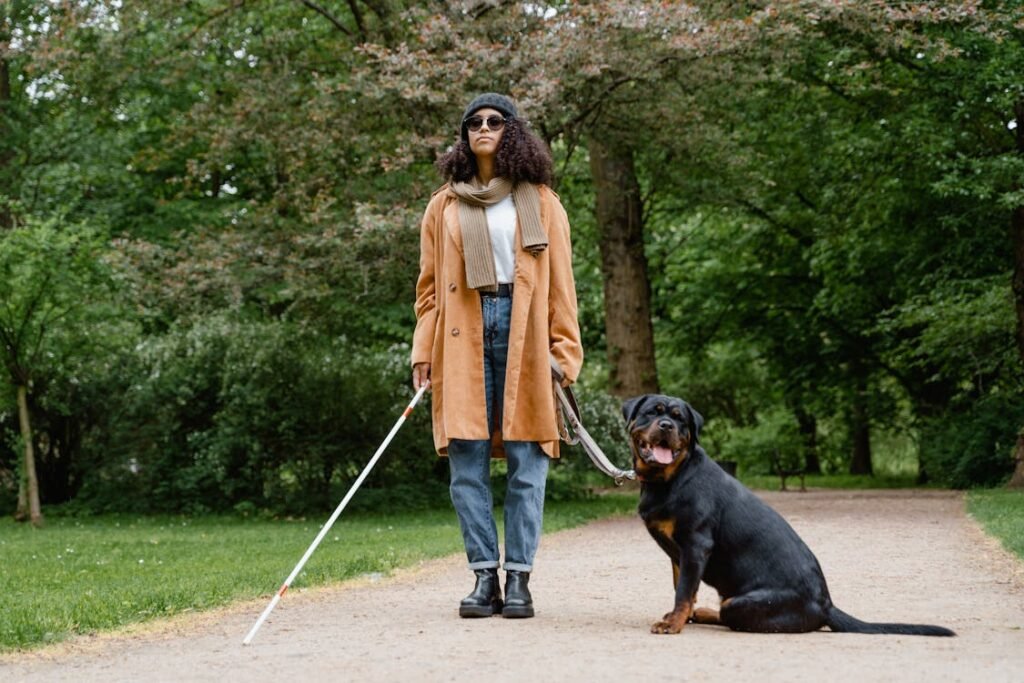
Smart Assistive Devices for Daily Navigation
Moving around safely and confidently is a major challenge for visually impaired individuals. Traditional white canes and guide dogs have long been essential tools, but modern technology has introduced innovative solutions that enhance mobility and navigation.
Smart Canes with Obstacle Detection
The traditional white cane has evolved into a smart cane, equipped with ultrasonic sensors that detect obstacles in the user’s path. These high-tech canes vibrate or produce audio alerts when they sense objects, allowing individuals to navigate more safely.
Some models even connect to smartphones via Bluetooth, providing additional guidance through voice instructions.
Unlike traditional canes, smart canes can detect objects above waist level, such as tree branches, hanging signs, or open cabinets, which often go unnoticed. This added awareness makes outdoor and indoor travel much safer.
GPS and Navigation Apps for Independence
Smartphone apps with GPS-based navigation are revolutionizing how visually impaired individuals travel. Apps like Be My Eyes, Lazarillo, and Seeing AI provide real-time navigation assistance, guiding users through streets, public transport stations, and indoor spaces.
These apps often integrate voice assistance, allowing users to receive step-by-step directions, identify landmarks, and even get notified about nearby restaurants, bus stops, or shops.
Unlike traditional GPS systems, which rely on visual maps, these apps describe the environment in spoken words, making it easier to follow a route independently.
Wearable AI Devices for Object and Text Recognition
Wearable assistive devices, such as AI-powered smart glasses, are changing the way visually impaired individuals interact with their surroundings. These devices use computer vision and artificial intelligence to recognize objects, read text, and even identify faces.
For example, some smart glasses can read menus, street signs, and handwritten notes aloud, making it easier for users to engage with the world around them.
Others use facial recognition technology to help users recognize friends, colleagues, or family members by providing an audio cue when they appear in view.
These devices empower users to shop, travel, and perform daily tasks independently, removing reliance on others for simple yet important activities.

Revolutionizing Access to Reading and Information
For visually impaired individuals, accessing written information has historically been a challenge. Books, newspapers, menus, and even digital content often rely on visual presentation, making them inaccessible without assistance.
Fortunately, advances in assistive technology have made reading easier and more convenient than ever.
Screen Readers and Text-to-Speech Software
One of the most widely used assistive technologies for visually impaired individuals is screen reader software. These programs convert digital text into speech, allowing users to navigate websites, read emails, and interact with apps through spoken words.
Popular screen readers such as JAWS (Job Access With Speech), NVDA (NonVisual Desktop Access), and VoiceOver (Apple’s built-in screen reader) make it possible for blind users to operate computers and smartphones effortlessly.
With keyboard shortcuts and voice commands, individuals can browse the internet, write documents, and even code without needing to see the screen.
Text-to-speech (TTS) technology has also become more refined, with AI-generated voices that sound natural and clear. This makes reading digital books, articles, and PDFs more enjoyable and accessible.
Many e-readers and apps, such as Kindle and Google Play Books, now come with built-in TTS features, allowing users to listen to books instead of reading them.
Braille Displays and Digital Braille Devices
For those who prefer tactile reading, modern refreshable Braille displays have revolutionized how visually impaired individuals consume written content.
These devices convert digital text into Braille characters using small, movable pins, allowing users to read books, emails, and messages through touch.
Unlike traditional printed Braille, which takes up a lot of space and is difficult to carry, digital Braille devices allow users to store thousands of books and documents in a compact format.
Some models even connect directly to smartphones and computers, making them an essential tool for education and professional work.
The advancement of Braille e-readers has also made it easier for students and professionals to access textbooks, academic papers, and work-related documents.
With the ability to scroll through pages and interact with digital content, these devices are closing the literacy gap for visually impaired individuals.
AI-Powered Reading Assistants
Artificial Intelligence (AI) is transforming the way visually impaired people read printed text. Devices like the OrCam MyEye and other portable AI readers can scan and read aloud text from books, newspapers, receipts, and even handwritten notes in real time.
These pocket-sized gadgets attach to eyeglasses and recognize text instantly, making them incredibly useful for reading restaurant menus, medicine labels, or price tags while shopping.
Some AI-powered assistants also recognize barcodes and product labels, helping users independently identify groceries and household items.
With these innovations, visually impaired individuals are no longer limited by print-based barriers. They can now read, learn, and stay informed with ease, whether in school, at work, or in everyday life.
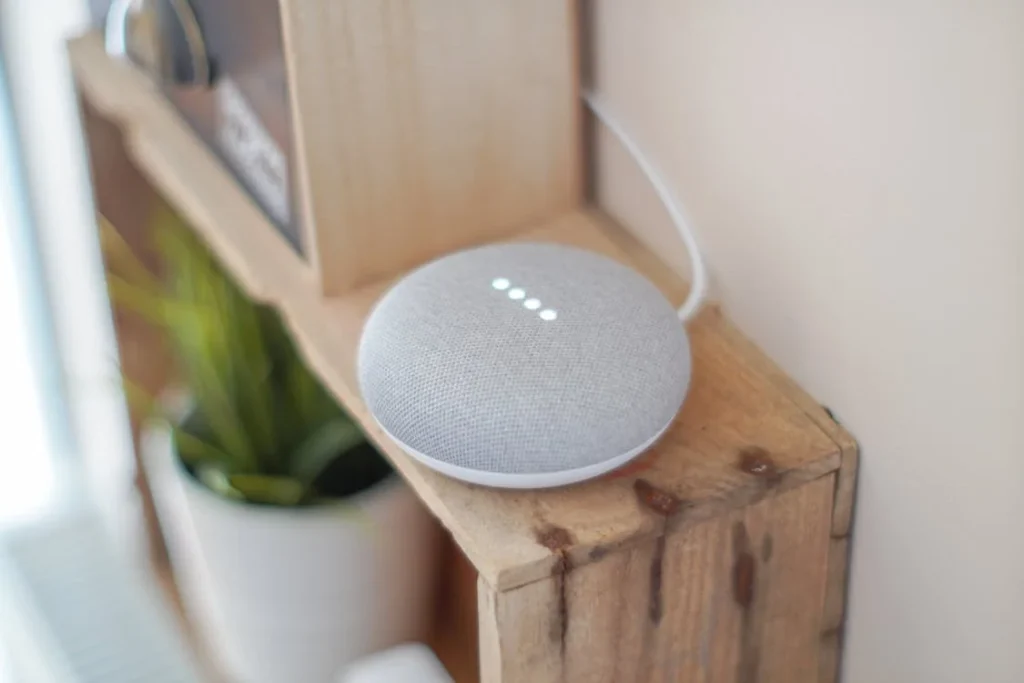
Smart Home Technology for Greater Independence
Living independently can be challenging for visually impaired individuals, but smart home technology is making daily tasks more accessible.
From adjusting lights to setting reminders, modern smart devices allow users to control their environment with voice commands, automation, and artificial intelligence. These innovations are transforming homes into safer and more convenient spaces.
Voice-Controlled Assistants for Hands-Free Operation
Smart assistants like Amazon Alexa, Google Assistant, and Apple Siri have become essential tools for visually impaired individuals. These devices respond to voice commands, allowing users to perform various tasks without needing to interact with a screen.
With a simple voice command, users can:
- Set alarms and reminders for medications, appointments, or important events.
- Control smart lights and appliances to turn them on or off without searching for switches.
- Ask for weather updates, news, and directions without using a smartphone or computer.
- Make phone calls or send messages hands-free.
These assistants integrate with other smart home devices, allowing users to operate thermostats, security systems, and entertainment systems effortlessly. By eliminating the need for visual interaction, voice-controlled assistants bring greater independence to everyday life.
Smart Doorbells and Security Systems for Safety
Traditional home security systems often rely on visual cues like camera feeds and flashing lights, making them less effective for visually impaired individuals.
However, modern smart doorbells and security systems offer audio-based alerts and voice integration, ensuring better safety and awareness.
Smart doorbells, such as Ring or Google Nest Hello, can announce visitors through voice assistants and send alerts via smartphone notifications. Some models allow users to speak to visitors remotely without needing to approach the door.
Smart security systems also integrate with motion sensors and emergency alerts, notifying users through voice notifications if unusual activity is detected. This provides peace of mind, especially for those living alone.
Smart Kitchen Gadgets for Independent Cooking
Preparing meals can be challenging for individuals with visual impairments, but smart kitchen gadgets are making cooking more accessible. Devices like talking induction cooktops, voice-controlled microwaves, and smart scales help users measure, heat, and cook food safely.
Smart kitchen devices can:
- Read out cooking temperatures and timers to prevent burns or overcooking.
- Measure ingredients accurately with talking measuring cups and scales.
- Use AI-based object recognition to identify ingredients and suggest recipes.
These tools empower individuals to cook with confidence, promoting independence and healthy living.
Automated Smart Lighting for Better Navigation
Lighting plays a crucial role in reducing falls and improving navigation for visually impaired individuals. Smart lighting systems allow users to adjust brightness, turn lights on or off, and even schedule lighting changes with voice commands or motion sensors.
Some advanced systems include motion-activated pathway lights, which illuminate walkways at night, preventing accidental falls. Others integrate with smartphone apps to adjust brightness levels based on time of day, making it easier to adapt to different lighting conditions.
By incorporating smart home technology, visually impaired individuals can enjoy greater independence, enhanced safety, and improved quality of life.
These innovations are reshaping the way people interact with their living spaces, ensuring that homes remain accessible and user-friendly.
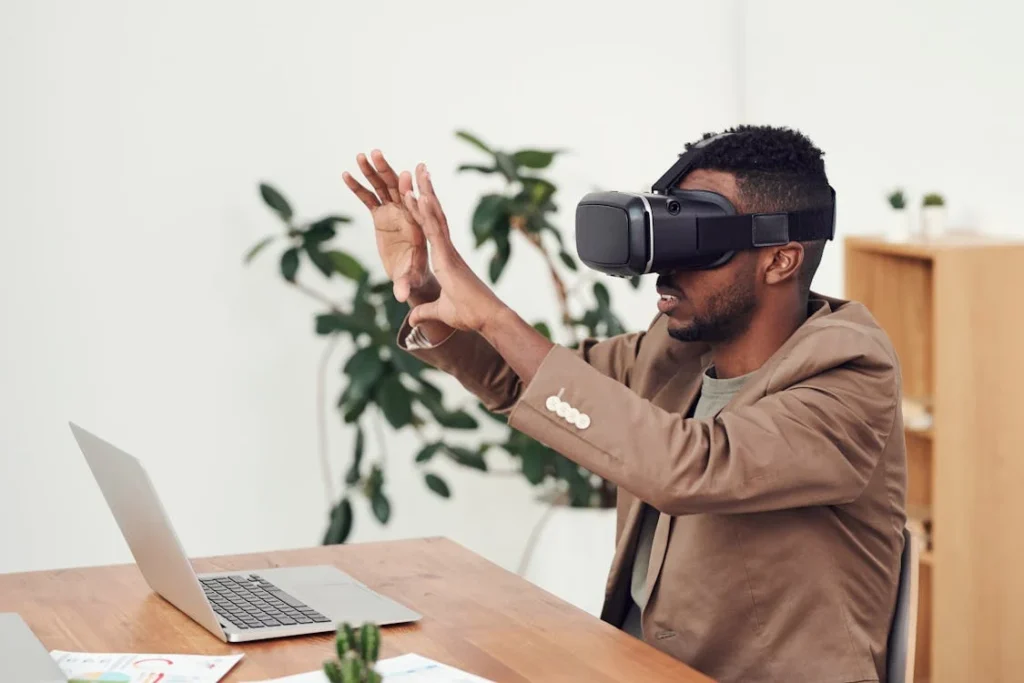
Assistive Technology for Communication and Social Interaction
Staying connected with friends, family, and colleagues is essential for emotional well-being and professional success.
For visually impaired individuals, traditional communication tools often present challenges, but assistive technology has made it easier than ever to interact with the world.
From accessible smartphones to AI-powered apps, modern solutions ensure seamless communication for both personal and professional use.
Smartphones with Built-In Accessibility Features
Modern smartphones are designed with advanced accessibility tools, making them indispensable for visually impaired users.
Apple’s iPhone and Android devices include built-in screen readers like VoiceOver (iOS) and TalkBack (Android) that convert on-screen text into spoken words, allowing users to navigate apps, send messages, and browse the internet independently.
Other key features that enhance accessibility include:
- Magnification tools, which allow users to zoom in on text and images.
- Voice commands, enabling hands-free control of the phone.
- Customizable contrast settings, improving visibility for low-vision users.
- Haptic feedback, providing tactile responses to screen interactions.
With these features, visually impaired individuals can easily stay in touch with loved ones, access social media, and handle work-related tasks without assistance.
AI-Powered Communication Apps
Several AI-driven apps help visually impaired individuals communicate more effectively. Apps like Be My Eyes connect users with sighted volunteers who can assist with reading text, identifying objects, or describing surroundings in real time.
This is especially useful for tasks like checking expiration dates on food products or choosing an outfit.
Other apps, such as Seeing AI, provide instant voice descriptions of text, objects, and even people. This allows visually impaired users to receive real-time feedback on their environment, improving communication and navigation.
For social interactions, voice-based messaging apps and video conferencing platforms with automatic transcription make virtual conversations more inclusive.
Features like real-time captions and AI-driven speech-to-text conversion allow individuals to engage in group discussions with ease.
Braille Notetakers and Digital Assistants for Work and Education
For professionals and students, Braille notetakers are transforming how visually impaired individuals take notes, write emails, and create documents. These devices feature refreshable Braille displays and voice output, allowing users to write and edit text efficiently.
Digital assistants like Google Assistant, Siri, and Alexa also support productivity by setting reminders, scheduling meetings, and dictating emails. These tools help individuals manage daily tasks while reducing reliance on visual interfaces.
With the right assistive technology, visually impaired individuals can maintain meaningful relationships, excel in their careers, and participate fully in social and professional life.
Advances in AI, voice recognition, and digital accessibility are ensuring that communication remains seamless and inclusive for all.
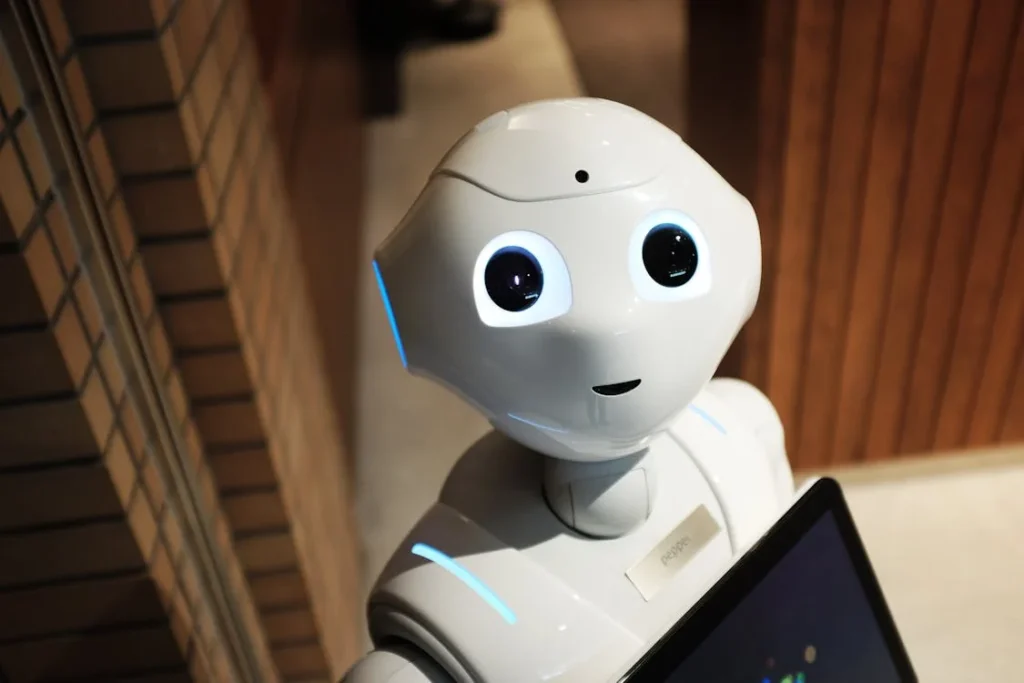
How Assistive Technology is Transforming Education for Visually Impaired Students
Education is a fundamental right, but for visually impaired students, traditional learning methods often present challenges. Reading textbooks, taking notes, accessing visual presentations, and participating in classroom discussions can be difficult without proper accommodations.
However, assistive technology is revolutionizing how visually impaired individuals learn, making education more inclusive, interactive, and engaging.
Digital Learning Platforms with Accessibility Features
With the rise of e-learning and digital education platforms, visually impaired students now have greater access to educational resources than ever before.
Learning management systems (LMS) like Google Classroom, Moodle, and Microsoft Teams are integrating accessibility features, ensuring that students who use screen readers or Braille displays can navigate coursework without barriers.
Many online courses now support text-to-speech (TTS) compatibility, audio-based lectures, and high-contrast modes to help students with low vision.
Interactive quizzes and exams have also become more accessible, allowing students to complete assignments independently using keyboard commands or voice input.
AI-driven tools are also helping convert traditional print materials into accessible formats.
Optical Character Recognition (OCR) technology can scan physical textbooks and turn them into editable digital text, which can then be read aloud or displayed on a Braille device. This ensures that students can keep up with their coursework without needing assistance.
Braille and Audio-Based Learning Tools
Traditional Braille textbooks take up a lot of space and can be expensive to produce. However, digital Braille displays and Braille e-readers are changing how students access written material.
These devices allow users to download and read textbooks, notes, and research papers in refreshable Braille, eliminating the need for bulky printed materials.
In addition, many universities and schools are adopting audio-based learning tools, where lectures, study guides, and even mathematical equations are explained through high-quality speech synthesis.
Podcasts and educational YouTube channels with descriptive audio narration are also helping students engage with complex subjects.
For subjects like science, technology, engineering, and mathematics (STEM), where visual diagrams are common, tactile graphics and 3D-printed models are providing hands-on learning experiences.
Students can now explore raised-line maps, molecular structures, and geometric figures through touch, ensuring they fully grasp abstract concepts.
Smart Note-Taking for Independent Learning
Taking notes in a traditional classroom setting can be difficult for visually impaired students, but assistive technology is making the process more efficient.
Braille notetakers, equipped with refreshable Braille displays and voice output, allow students to type notes quickly and review them later. These devices can also connect to smartphones and computers, making it easier to organize study materials.
For those who prefer audio-based learning, AI-powered smart pens and voice recorders are valuable tools.
Some smart pens can record lectures while simultaneously converting spoken words into digital text, allowing students to listen and review information at their own pace.
These tools enhance retention and comprehension, ensuring that students don’t miss important details.
Virtual Classrooms and Remote Learning Accessibility
The shift to online education and remote learning has highlighted the importance of digital accessibility.
Many educational institutions are now prioritizing captioned video lectures, screen-reader-friendly study materials, and keyboard-navigable websites to support visually impaired students.
Virtual reality (VR) and augmented reality (AR) are also playing a role in making remote learning more immersive.
Some VR applications now provide audio-based simulations of historical sites, scientific experiments, and art galleries, allowing students to experience learning in a new way.
As educational institutions continue to adopt accessible technology, visually impaired students are gaining more independence and confidence in their academic pursuits.
The combination of AI, digital Braille, and smart learning tools is ensuring that education remains a right, not a privilege, for everyone.
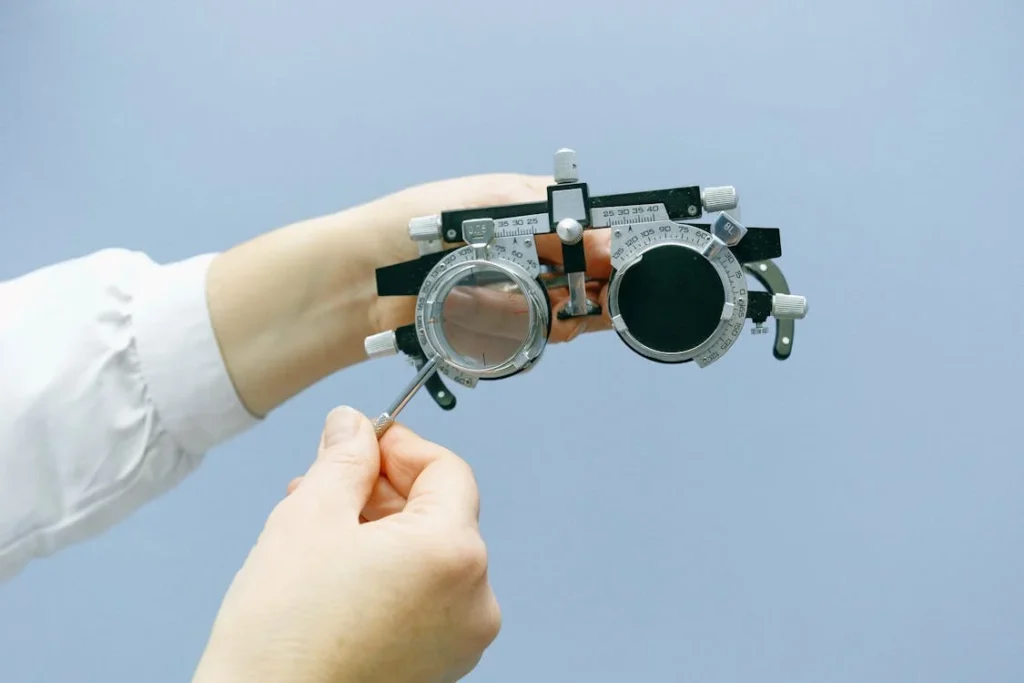
The Future of Assistive Technology for the Visually Impaired
Technology is evolving rapidly, and the future of assistive devices for visually impaired individuals is more promising than ever.
Advances in artificial intelligence (AI), wearable technology, and smart infrastructure are paving the way for even greater independence, mobility, and accessibility.
As innovation continues, new tools and solutions will further bridge the gap between vision impairment and full participation in society.
AI and Machine Learning: Creating Smarter Assistive Devices
AI is already enhancing accessibility through screen readers, voice assistants, and object recognition apps, but future developments promise even smarter and more intuitive assistive devices.
AI-powered tools are expected to improve real-time scene recognition, allowing users to navigate complex environments with greater ease.
For example, AI-powered smart glasses may soon provide advanced depth perception and instant scene descriptions, helping users identify crosswalks, traffic signals, and moving obstacles.
These devices could translate visual information into detailed audio descriptions, making independent travel even more seamless.
Another breakthrough in AI is the development of real-time sign reading technology. Soon, wearable devices may be able to instantly recognize and translate printed text into speech, including handwritten notes, restaurant menus, and road signs in multiple languages.
Brain-Computer Interfaces (BCIs) for Sensory Enhancement
One of the most futuristic innovations in assistive technology is brain-computer interfaces (BCIs). These devices connect directly to the brain, allowing users to interact with digital systems using neural signals rather than physical input.
Researchers are exploring how BCIs could help visually impaired individuals interpret digital text, images, and even virtual environments without needing a screen or external hardware.
While still in early development, BCIs have the potential to transform accessibility in ways never seen before.
Future versions may allow users to “see” their surroundings using direct sensory feedback from AI-powered neural processors, completely bypassing traditional sight-based limitations.
Smart Cities and Connected Infrastructure for Seamless Mobility
The concept of smart cities is revolutionizing accessibility in public spaces. Many urban centers are investing in AI-driven traffic signals, voice-assisted kiosks, and smart crosswalks, making cities more accessible for individuals with vision impairments.
Imagine a world where traffic lights announce crossing signals via smart earbuds, bus stops provide real-time voice navigation, and buildings are equipped with Bluetooth beacons that guide users with precise step-by-step directions.
These advancements would create a more independent and stress-free urban experience.
Smart cities also integrate automated public transportation alerts, ensuring visually impaired individuals know exactly when and where to board a train or bus, reducing reliance on sighted assistance.
As cities embrace inclusive technology, mobility and accessibility will become more effortless than ever.
Haptic Feedback Technology for Tactile Navigation
Haptic feedback technology is playing an increasingly important role in assistive devices. Future smartwatches, gloves, and even shoes may use vibration-based alerts to guide visually impaired users through unfamiliar environments.
For example, haptic navigation vests can provide subtle vibrations to indicate direction, alerting users when to turn left, right, or stop at an obstacle. Similarly, smart shoes with vibration sensors could notify wearers of changes in terrain, such as curbs, stairs, or potholes.
These innovations would provide a silent, discreet way to navigate safely, removing the need for constant audio feedback and allowing users to move confidently through crowded or noisy areas.
A Future Without Barriers
The next decade will bring unprecedented improvements in assistive technology, making everyday life for visually impaired individuals more independent, efficient, and connected.
With AI, wearable devices, and smart city integration leading the way, the future of accessibility looks brighter than ever.
As these technologies continue to develop, they will empower individuals to live, work, and travel with confidence, ensuring that vision loss is no longer a barrier to success and independence.
Conclusion
Assistive technology is transforming the lives of visually impaired individuals, empowering them with greater independence, accessibility, and opportunities. From smart navigation devices and AI-powered reading tools to accessible education and smart home automation, innovation is breaking down barriers like never before.
These advancements are not just about convenience—they ensure that visually impaired individuals can work, learn, communicate, and navigate the world with confidence. The future of assistive technology looks even more promising, with AI, wearable tech, and smart cities paving the way for an even more inclusive society.
At Robobionics, we believe in the power of technology to restore independence and dignity to those facing physical challenges. Just as we innovate in prosthetic solutions, the world of assistive technology is proving that no disability should limit a person’s ability to live life fully.
With continued advancements, advocacy, and awareness, we are moving toward a world where everyone has equal access to opportunities, resources, and a better quality of life—regardless of ability. The future of accessibility is here, and it’s only getting brighter.



